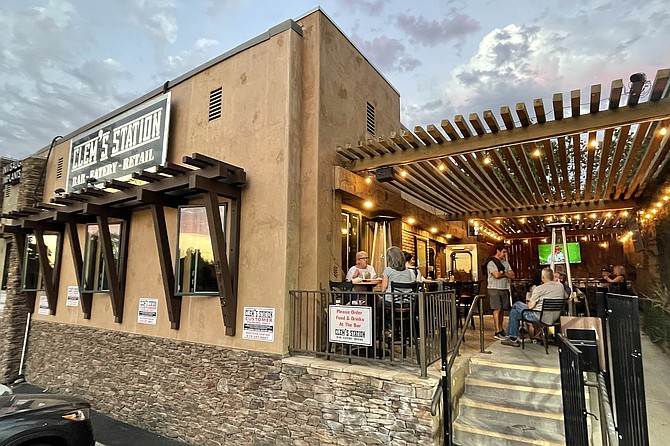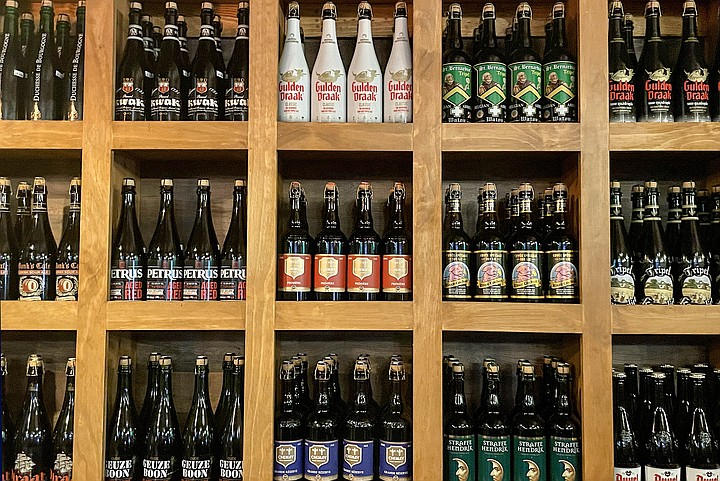 Facebook
Facebook
 X
X
 Instagram
Instagram
 TikTok
TikTok
 Youtube
Youtube

Did you know there’s a neighborhood in San Diego specifically named after silent film actresses of the 1920s? I was surprised to learn this week that Talmadge was founded in 1925, named in honor of the Talmadge Sisters, Norma and Constance, two of the world’s most popular movie stars at the time. According to neighborhood historians, Norma’s wealthy, producer husband funded the development, and the dedication ceremony naming it was attended by the sisters, as well as their brother in-law, the better-remembered silent film star, Buster Keaton.
That’s the second thing I ever learned about the small, the mostly residential neighborhood, which is sequestered by canyons on three sides, and overshadowed by Little Saigon to the south. The first thing I ever learned is it was home to neighborhood wine bar, Romeo y Julieta, as distinctive for the [authentic Polish food on the menu][2[ as for its globally-sourced wine list.
Unfortunately, the charming, continental-feeling wine pub — effectively the neighborhood’s only restaurant — did not survive the pandemic. While this likely puts a permanent end to Talmadge’s status as San Diego’s premier pierogi destination, the venue did not remain empty for long, and the new occupants have steered in a slightly different direction.

The brick arch windows and bronze ceiling tiles remain, and if anything there are more European bottles on display. But rather than wine, the bottles lining the walls of what is now Clem’s Station are filled with fine Belgian beer.
Which will make sense to those familiar with Clem’s branded businesses in the neighboring community of Kensington, just across the canyon to the west. Clem’s Bottle Shop has long been one of the best-stocked beer retailers in town, particularly with regard to higher-end bottles of aged beer, and imports. And thanks to an ongoing relationship with local and regional beer producers, its neighboring Clem’s Taphouse has been similarly well stocked with draught brews.

With each successive business, Clem’s venues have been steadily putting more of an effort behind food. The bottle shop includes a deli counter offering full array of sandwiches. But Clem’s Station picks up more where the taphouse leaves off, offering pizza and pub fare from behind a bar banked by television screens generally tuned to sports, as available.
Where it differs is in offering more robust dining space, bolstered by a comfortable patio — also with TV — which may prove the best place for Talmadgians (Talmadgites?) to gather for drinks and bites.

Drinks-wise, it may be impossible to do better than those tall bottles of Belgian ale, which represent many centuries’ worth of thirst-quenching brewing traditions from the likes of Chimay, Duvel, and Kwak. But should you want to try, there are no shortage of options, in addition to about thirty taps of fresh beer, Clem’s has kept a fair selection of wines for the asking, and more than enough liquor to appease cocktail fans.
Given the atmosphere and drinks for days, it’s only on the food end that the arrival of Clem’s will feel like a step down to locals. That’s not to say anything’s bad enough to turn people off: burgers, salads, and wings are easy sells alongside beer and wine, and pizza always proves a crowd pleaser.
But it mostly hits the benchmark of “decent”: serviceable food that you’d be happy to eat and ignore when the true purpose of your visit is to meet up with neighbors, friends, and family to enjoy a few beverages and loads of conversation. Maybe a game. The 12-inch pies reflect this, with their water-cracker like crust and thick, elastic layer of cheese covered in a healthy ration of toppings: it gives you just enough to like while you eat it, yet not enough to remember once you’ve left. Take some home for the kids, and they’ll eat it all, with a shrug. And a smirk. And a title card that reads, “What’s for dessert?”


Did you know there’s a neighborhood in San Diego specifically named after silent film actresses of the 1920s? I was surprised to learn this week that Talmadge was founded in 1925, named in honor of the Talmadge Sisters, Norma and Constance, two of the world’s most popular movie stars at the time. According to neighborhood historians, Norma’s wealthy, producer husband funded the development, and the dedication ceremony naming it was attended by the sisters, as well as their brother in-law, the better-remembered silent film star, Buster Keaton.
That’s the second thing I ever learned about the small, the mostly residential neighborhood, which is sequestered by canyons on three sides, and overshadowed by Little Saigon to the south. The first thing I ever learned is it was home to neighborhood wine bar, Romeo y Julieta, as distinctive for the [authentic Polish food on the menu][2[ as for its globally-sourced wine list.
Unfortunately, the charming, continental-feeling wine pub — effectively the neighborhood’s only restaurant — did not survive the pandemic. While this likely puts a permanent end to Talmadge’s status as San Diego’s premier pierogi destination, the venue did not remain empty for long, and the new occupants have steered in a slightly different direction.

The brick arch windows and bronze ceiling tiles remain, and if anything there are more European bottles on display. But rather than wine, the bottles lining the walls of what is now Clem’s Station are filled with fine Belgian beer.
Which will make sense to those familiar with Clem’s branded businesses in the neighboring community of Kensington, just across the canyon to the west. Clem’s Bottle Shop has long been one of the best-stocked beer retailers in town, particularly with regard to higher-end bottles of aged beer, and imports. And thanks to an ongoing relationship with local and regional beer producers, its neighboring Clem’s Taphouse has been similarly well stocked with draught brews.

With each successive business, Clem’s venues have been steadily putting more of an effort behind food. The bottle shop includes a deli counter offering full array of sandwiches. But Clem’s Station picks up more where the taphouse leaves off, offering pizza and pub fare from behind a bar banked by television screens generally tuned to sports, as available.
Where it differs is in offering more robust dining space, bolstered by a comfortable patio — also with TV — which may prove the best place for Talmadgians (Talmadgites?) to gather for drinks and bites.

Drinks-wise, it may be impossible to do better than those tall bottles of Belgian ale, which represent many centuries’ worth of thirst-quenching brewing traditions from the likes of Chimay, Duvel, and Kwak. But should you want to try, there are no shortage of options, in addition to about thirty taps of fresh beer, Clem’s has kept a fair selection of wines for the asking, and more than enough liquor to appease cocktail fans.
Given the atmosphere and drinks for days, it’s only on the food end that the arrival of Clem’s will feel like a step down to locals. That’s not to say anything’s bad enough to turn people off: burgers, salads, and wings are easy sells alongside beer and wine, and pizza always proves a crowd pleaser.
But it mostly hits the benchmark of “decent”: serviceable food that you’d be happy to eat and ignore when the true purpose of your visit is to meet up with neighbors, friends, and family to enjoy a few beverages and loads of conversation. Maybe a game. The 12-inch pies reflect this, with their water-cracker like crust and thick, elastic layer of cheese covered in a healthy ration of toppings: it gives you just enough to like while you eat it, yet not enough to remember once you’ve left. Take some home for the kids, and they’ll eat it all, with a shrug. And a smirk. And a title card that reads, “What’s for dessert?”
Comments